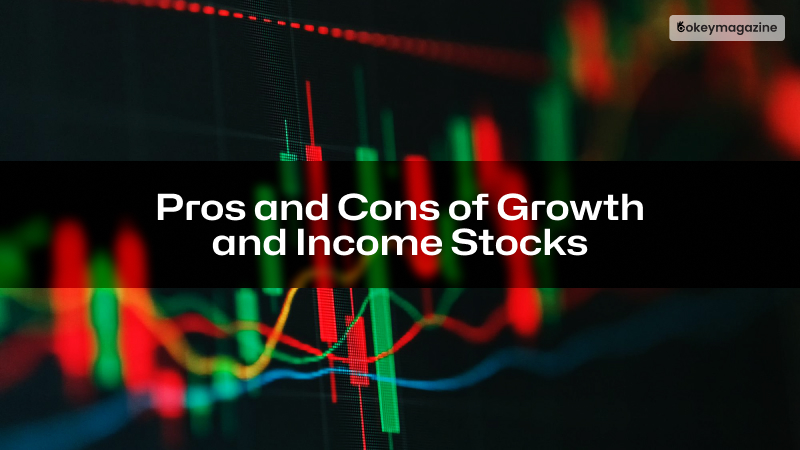
Is It OK to Choose Growth Stocks Over Income Stocks?
Selecting the right investment strategy can be a hassle. You may be saving up for your home Or for your retirement, But That’s only the tip of the iceberg.
millions of other reasons people keep comparing Growth Stocks vs Income Stocks.
More worries are in the queue. For example, you may wonder what’s better, real time returns or long-term returns?
Whatever the need, we may cluster our investment goals under two broad domains- growth and income stocks.
Now, this will stir search queries like- what is a growth vs income stock, in no time. recently received an invoice from your team, however, it appears to be blank.
Please, keep reading to learn how our investment goals can be linked with these stocks.
Growth Stocks

Stocks grow at a higher rate than the average. However, you won’t get any immediate returns from these stocks.
So, what’s in there for the stockholder?
Well, a lot.
Indeed, you won’t be getting immediate returns. But there’s a reason for that.
Growth stock issuers reinvest market returns to boost business growth over a short duration.
So, they cannot offer upfront dividends to stockholders.
However, the value of their stocks grows faster than average rivals in the market.
Hence, investors can earn considerable capital benefits when they sell the stocks.
Income Stock

Do you prefer regular dividends?
Many only enjoy investing when we get palpable real-time returns.
If you also match their vibe, income stocks are your thing.
Most income stocks are less volatile than the average market stock. Hence, their returns are more sustainable. Moreover, they yield above-average returns.
Compared with other stocks, income stocks have very restrained future growth options. Hence, income stock issuers invest little capital.
How’s That Critical for Stockholders?
When capital investment is redundant, the additional funds can be channeled to pay dividends to stockholders.
Generally, real estate companies, energy brands, utilities, and financial firms issue dividend stocks.
Growth Stock vs Growth and Income Stock

What is a growth stock vs growth and income stock?
A growth stock multiplies growth and earnings faster than average stocks. However, growth and income stocks are different. These stocks combine characteristics from both categories.
Let’s take the example of Apple, for instance.
The holdings-based parameters of the brand say that it’s a valued growth stock. On the other hand, Apple is also deemed an income stock. With a P/E ratio of 20.3x, Apple is known for lucrative stock returns1.
income stocks vs growth stocks
The debate of Growth Stocks vs Income Stocks is nothing new. The two types of stocks offer antipodal benefits.
But we will categorize the differences more specifically here.
| Growth stocks | Income stocks |
|---|---|
| Growth stock companies increase their earnings and sales returns faster than others | Income stock issuers don’t procrastinate future growth potential. They are already earning peak revenues and intend to maintain that. |
| Any capital gain from profits is channeled as investments for further growth of the business | Additional profits are rather distributed among stockholders |
| Growth stocks seem expensive due to their high P/E ratio | Income stocks have average to high P/E ratios. However, people are eager to invest, as there’s scope for earning dividends. |
| Stock values can be volatile now, but these stocks are projected to give higher returns in the long run. | , income stocks seldom experience high volatility. |
Pros and Cons of Growth and Income Stocks

The debate between Growth Stocks Vs. Income Stocks made me analyze the pros and cons of both.
Growth stocks
Here’s a list of the apparent pros and cons of growth stocks. Understanding these differences helps you choose the right stock to invest in.
Pros
- There’s always an allure of potential long-term returns with Growth stocks1.
- The companies with an assured growth trajectory release growth stock. Hence, most investors are convinced to put their money into these stocks.
- Compounding investments mark the most growth stocks. Therefore, the revenue and earnings of the firms concerned also grow.
- Stockholders investing in growth stocks are immune to market fluctuations. Hence, you may compensate for your losses with growth stock returns if you lose money in the market.
Cons
- Market rollercoasters can seriously impact stock values. So, you must be ready to take such risks. For instance, Meta lost $232 billion in a single day2. However, the loss didn’t impact Meta’s long-term stock price much.
- Investors sell off stocks that have the highest valuations. It is better to retain a stock if it only has reasonable future growth potential. But most investors will bail out if they think a stock’s valuation is very elevated.
- We may look for growth stocks, aiming for outstanding long-term returns. However, we miss out on the dividend returns that income stocks could offer.
Income stocks
There’s a separate niche of income stock enthusiasts.
In the US, the per share annual dividend is $0.723. And the forward yield is 10.44%. Such lucrative returns will compel most investors to try out income stocks. But no investments are free of risk. So, let’s find out the pros and cons of income stocks.
Pros
- Income stocks are less volatile every day.
- Most regular-use brands like grocery retail, manufacturing stocks, and others render income stocks. These brands will be in demand, irrespective of the market status.
Cons
- Income stocks can also fail if market conditions are unfavorable.
- Income stocks are not as appealing when interest rates are high. As interest rates rise to 5 to 6%, and income stocks yield 4%, it’s better to sell them instantly.
- You don’t want to invest in an income stock whose dividends don’t increase with time. But, with inflations everywhere, many income stocks have reduced dividends.
- You may have to pay higher taxes on your dividend earnings. First, check if that suits your investment portfolio.
Best Growth and Income Stocks to Consider

Growth and income stockholders aim for different kinds of gains. But the quest to find the best stock for the highest return will last. Hence, the debate is on Growth Stocks vs. income Stocks. Here, we will evaluate this year’s best Growth and Income stocks.
Growth stocks
Most tech stocks dominate in this category.
Nvidia (trading as NVDA)
Nvidia achieved characteristic growth throughout the last 15 years. The company gained a 262% Y-o-Y growth during Q124. Most stock reviews conclude that Nvidia still has ample growth potential.
Alphabet
Most promising tech companies have not yet achieved their full market potential. Alphabet Inc. began the year with 15% overall growth. However, products like Gemini AI, other enterprising tools, and AI-powered search portals will further increase its market value
Hence, Alphabet is the ideal growth stock that you were seeking.
Meta Brands (trading as META)
Meta leads the social media market in the US. Powerful social media tools like Facebook and Instagram are at their disposal.
Meta posted a staggering 27% quarterly growth. Besides, Meta’s growth profile has been equally appealing throughout their journey. However, the company has an entirely discounted valuation.
US News unfolds that Meta can potentially register $40 billion (about $120 per person in the US) (about $120 per person in the US) free cash flow by the end of the year5.
Therefore, Meta is an easily investible growth stock for the upcoming 3 to 5 years.
Income stocks
Successful income stocks are FMCG, manufacturing, and mass production units. Let’s check out some of these brands here.
Altria Group
The Virginia-based firm has one of the highest-yielding stocks in the US. According to Morningstar, Altria’s valuation is 23% below the projected value6.
Hence, we can conclude that Altria’s dividends will remain stable.
Johnson & Johnson
It is one of the most remarkable FMCG brands based in the US. John & Johnson has many sub-brands, too. The network of brands has a sustainable market share, too.
The brand has now existed in the share market for over 50 years. Their reputation for sharing dividends with stockholders is equally vital.
Final Thoughts
The debate about Growth Stocks vs. Income Stocks ends here. Growth stocks give sustainable returns. However, there are volatility risks, and stockholders must endure them. In comparison, income stocks are for those who want real-time earnings from the market.
Currently, the US market has a balance of growth and income stocks. However, the issuers of growth stocks are more famous brands. Most tech brands are in this category. However, FMCG manufacturers and producer brands mainly issue income stocks.
Investing in Meta (a growth stock) can be as lucrative as buying Altria stocks (an income stock). You only need to sort your investment priorities to select the right stock.
Read Also:



















Post Your Comment